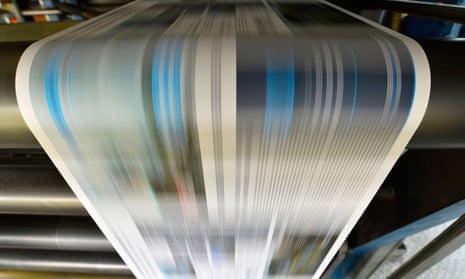Here is the news. Newspaper publishing revenues from both circulation and print advertising, have plunged by more than half over the past decade, down from almost £7bn to just over £3bn. Here’s more news. Over those 10 years, the number of journalists employed by publishers of news brands has fallen by 26%, down from 23,000 to 17,000.
And here’s yet more news. In the same period, the average weekly circulation among Britain’s regional and local newspapers decreased by 51%, from 63.4m to 31.4m, partially the result of title closures, most of which were giveaway papers.
You may say these statistics, drawn from a 90-page Mediatique report commissioned by the Department for Culture, Media and Sport, tell us nothing new. Anyone with a passing interest has long been aware of the gloomy truth about the demise of newsprint. It was forecast at the end of the last century – although too few people, including most of the key figures within the trade, refused to acknowledge its implications. It meant that publishers, confronted by the erosion of the ink-on-paper platform, failed to devise a positive strategy to prevent the inevitable, existential effects on journalism.
Why the delay? There were three overlapping reasons. Initially, there was a denial of reality – a belief, despite the evidence, in the durability of print, and a parallel misconception about the impact of the digital revolution. I lost count of the times I heard head-in-sand nonsense about the survival of papers. “We beat off radio, we accommodated television, and we will see off the net.” Oh yeah?
Secondly, and crucially, the crisis of an accelerating decline in the popularity of newspapers revealed the disconnect between journalism as a business, and journalism as a public service. So, in response to falling profit margins, owners instituted cost-cutting on a scale that has, over time, eroded the quality and quantity of editorial output. Journalism has taken second place to profitability.
Thirdly, a competitive, free-market culture ensured that owners would seek to act against each other. To that end, they have been engaged in a last-man-standing gameplan in the belief that the winner takes all. It may make business sense, but it sounds the death knell for journalism.
Meanwhile, until very recently, publishers – particularly those responsible for regional and local news brands – have been guilty of a disgraceful deception. While denuding their organisations of journalists, they maintained that news coverage did not suffer. Despite copious evidence to the contrary, with judges complaining about empty press benches in courtrooms and local politicians enjoying the absence of reporters at council meetings, newspaper owners pooh-poohed critics (such as me) who warned of their failure to fulfil their public service remit.
Even before social media, it was obvious that the business model underpinning newspaper publishing could not be sustained. Advertising revenue would continue to decline, and falling sales meant circulation revenue would also drop away.
In such circumstances, if we wanted journalism, as distinct from newspapers, to survive, it was necessary to contemplate new forms of funding. One alternative I championed was a public subsidy, similar to the BBC licence fee. This was anathema to publishers. It was counter to their ethos, they argued, protesting disingenuously about it being a threat to freedom of the press – thereby implying that their own form of ownership, and the funding of journalism by advertising, is press freedom’s perfect formula.
Belatedly, publishers admitted that their cuts had, as predicted, reduced coverage. They were forced to go into partnership with the BBC, which agreed to fund 150 “local democracy reporters”. More, inevitably, will be required.
At the same time, publishers complained, campaigned and lobbied against social media, especially Facebook and Google. The result was the decision by culture secretary, Matt Hancock, to launch a review – chaired by Dame Frances Cairncross – into “what intervention might be required to safeguard the future of our free and independent press”. Hence the Mediatique report, a prelude to that review.
I take heart from Cairncross’s statement that it “is not about preserving the status quo”. She said: “We need to explore ways in which we can ensure that consumers in 10 years’ time have access to high-quality journalism which meets their needs, is delivered in the way they want, and supports democratic engagement.”
Good stuff, but I also note that she has recruited an 11-strong advisory panel which includes publishers who have been responsible for journalism’s deterioration, and who have a vested interest in making profits, rather than aiding democracy.
While I share with those publishers a belief that Google and Facebook could do more to underwrite independent journalism, I am eager to see the emergence of funding innovations that they have so far opposed. There must be transitional support, via government if necessary, for news organisations prepared to consider a mixed economy: philanthropy; informal public contributions (as the Guardian is doing); formal public subsidies; payments for partial online access; and, yes, advertising too. At the same time, there needs to be an acceptance of the benefits of pooled reporting and a measure of stimulation for freelance agencies.
Cairncross is prepared to accept written evidence from anyone over the next two months and hopes to produce a report early next year. There is a sense of this being a last-chance saloon. Journalists who care about our trade should not miss the chance to take their place at the bar.
A warning we must heed
The murder of five staff at the Capital Gazette in Annapolis, Maryland, is the fusion of two macabre phenomena in Donald Trump’s America. One, which predates his regime, is regular mass shootings. The other is the Trump-inspired demonisation of the media.
Doubtless, the president’s apologists will cast Jarrod Ramos’s bloody rampage in the newsroom as a one-off. It is absurd, they will argue, to view Trump’s oft-quoted complaints about journalists as giving “permission” for a man with a grudge to go on a killing spree.
But we should not ignore the link between statements by the nation’s commander in chief and the actions of those able to bear arms due to Trump’s acceptance of a wilful misinterpretation of the second amendment, and his refusal to pass strict gun-ownership laws.
Trump views journalists as the enemy. He takes every opportunity to denigrate them, accusing them of purveying fake news, and seeks to undermine their attempts to hold his administration to account.
In so doing, he gives encouragement to people to treat reporters as an alien force.
The very real danger now is of copycat attacks. It appeared momentarily excessive when a BBC TV correspondent referred in the aftermath of the tragedy to the need for an “abundance of caution” at newspaper offices. Her concern, on reflection, was absolutely right.

